Blog Archives
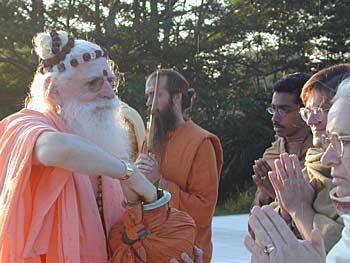
Gurudeva:
“Therefore, we have to meditate on these things. God Siva is so close to us. Where does He live? In the Third World. And in this form He can talk and think and love and receive our prayers and guide our karma. He commands vast numbers of devas who go forth to do His will all over the world, all over the galaxy, throughout the universe. These are matters told to us by the rishis; and we have discovered them in our own meditations. So always worship this great God. Never fear Him. He is the Self of your self. He is closer than your own breath. His nature is love, and if you worship Him with devotion you will know love and be loving toward others. Devotees of God Siva love everyone. “
Our Beloved and Revered Satguru Sivaya Subramuniyaswami
Attained Maha Samadhi on November 12th, 2001
Click to read for Details.
Mystic Mouse Coloring Book Now available
Today’s sample page. —– Click here to get your copy today!
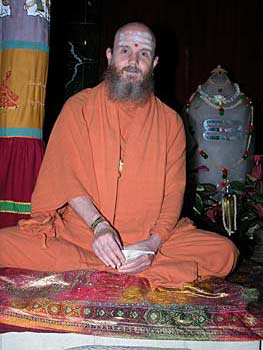
No Audio Today
|
Take this opportunity for an adventure. Close your eyes and click to get a message picked at random from the vast audio archives of our Satgurus’ discourses |
And click here for an Index to All Past CyberTalks. Study Gurudeva’s teachings. Visit the Master Course site! |
 |
|
|
 |
||
Sannyasin Shanmuganathaswami takes care of our members’ communications around the world. Here he processes Saiva Siddhanta Membership Applications from a new group of Himalayan Academy students who have completed their study and have become Vrata Sishya.
Recently someone sent a gift of small crystals taken from the same mine where the big Maha Spatika Sivalingam was found in Arkansas… then a few days later someone else did the same… it was also most as if the Big Crystal was calling for the “Little Crystals” to come join it here on Kauai.
Arumugam, son of A. Manivelu in Chennai completed his first attempts and 3 dimensional modelling with this bas relief of Gurudeva.
Those who saw it in Chennai said it was like Gurudeva was looking at them through a window.
This one was painted with gold paint qnd has a mystical vibration.
 The Remarkable Vision |
Iraivan Temple Progress Update |
Join this historic undertaking. Please contribute generously. Sponsor a stone today! |
| Order Sacred Rudrakshas and help Iraivan. | ||
A close up of work from course number 12.
Our stapathi and his team of silpis face new challlenges daily as the temple rises. Getting two ton rocks up 18 feet is not small feat.
This is the top of the door to the main sanctum.
course twelve will be a several feet above your head as you go around the sanctum.
Shanmuga Stapathi is starting a new strategy to make sure the team will always have work at hand. On sunny days everyone will work on stones on the foundation itself and then on rainy days move up to work under the covering over the sanctum.
These beams that project out from the sanctum require some major work and it is much easier to do it down here.

We bring you a wonderful manifestation of Gurudeva’s vision. Here we are at the Manjung Orphanage in Malaysia which is one of the institutions that has a fund in the Hindu Heritage Endowment fund. One of Gurudeva’s lady students, Brahmacharini Shantidevi is a key person on the staff. One of our Alaska Innersearcher’s, Sheila Evani, asked for ideas on how to use her summer break from University to serve Hinduism and we suggested the opportunity to go serve in Malaysia. She sends back pictures and her story to us today:
~~~~~~~~~~~~~~~~~~
Living the Language of Love
By: Sheila Gayatri Evani
Abbotsford, Canada
This summer I spent two months working with thirty children at an Ashram in Malaysia. While I was there, I learned many things�about myself, about humanity, and about the meaning of life in general. Now that I’m home, I feel different. I am re-charged and ready to better face what challenges and lessons this life was meant to teach me.
My time in Malaysia was a time of renewal and self-discovery. At first, I believed going to the ashram because it was an opportunity to see the world and experience a different culture while doing some public service. What I realize now that is that I also needed to take a short break from the rat race that had become my life, and get some perspective.
To introduce myself, I am an ordinary Hindu girl, born and raised in Canada who has been blessed with everything she has ever really needed. I have an extraordinary family that loves me, and has instilled in me positive values and a deep appreciation for our Hindu heritage. I have good friends who have always supported me in my personal and academic pursuits.
Despite all of this, I could not help feeling dissatisfied. My whole life I had single-mindedly devoted myself to my academic and career development. What was lacking was the opportunity to better develop both personally and spiritually.
I knew this summer would be better spent building character rather than my resume–seeing the world while helping people at the Sanathana Dharma Ashram in Sitiawan, a small coastal town in Northwest Malaysia.
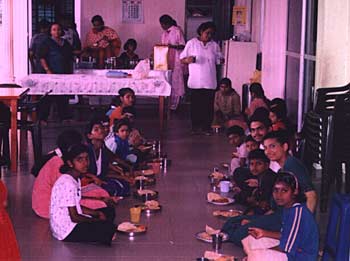
The ashram is a foster home for underprivileged Hindu children. It is a beneficiary of the Hindu endowment fund, and is run entirely by the Sitiawan chapter of the Malaysian Hindu Society. The Ashram’s mandate is to not only provide for the material and physical needs of the children, but also to instill religious and spiritual values. Unlike similar foster homes in Malaysia, this is a vegetarian home, where the children participate in daily Hindu instruction and prayers.
Upon hearing about the opportunity to assist in such a noble undertaking, I promptly booked my ticket. Without any hesitation, I began preparing myself for what I knew would be a wonderful, life changing adventure.
I was asked to expect no luxuries, and told I would live, sleep and eat with the children. I was also warned that although the children were basically good-hearted, most of them came from very rough backgrounds of neglect and abuse. As a result, they had many bad habits and behavioural problems that frequently arose.
Understandably, I was nervous when I was first brought to the ashram. I was prepared for the worst but knew that with Gurudeva’s blessings, things would take care of themselves. Imagine my relief to find a brand new, beautiful building as modern as anything you would find in more developed areas of Malaysia. The building was spotless, with a large well lit hall for pooja, recreational classes and community religious functions. There were two large bedrooms for the boys and girls that came complete with fans, mosquito netting and very comfortable beds. Finally, not only was there indoor plumbing, but also the added luxury of a hot water shower. The children themselves were a far cry from ragged little delinquents I had expected. They were beautiful, healthy, well-dressed children. In fact, many of them were wearing much better clothing than I was! Had I met them anywhere else, I would not have guessed they were living in an ashram.
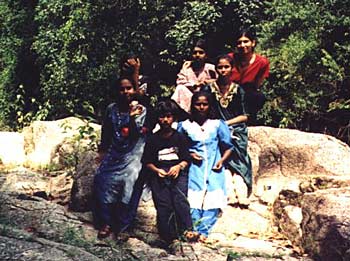
They were remarkable. I remember being swarmed by the children that first night I arrived. The only thing I could think was, “How will I learn all of their names?” The youngest child was 2, and the eldest was seventeen. While I couldn’t help but feel overwhelmed and a bit intimidated, I was soon touched by their generosity and warmth right from the very beginning. One of the girls gave up her bed so I would have a comfortable place to sleep. They gave me their grandest clothes if I had nothing appropriate to wear for a prayer function, or outing. They fed me their own food if they thought I had not yet eaten or was still hungry. It melted my heart that although I was there to take care of these children, they were very often the ones who took care of me. They soon became my friends, siblings, guardians, and children.
When I first met Uncle Aramban Kumar, the principle of the Ashram, he asked me what my intentions were during my stay. I must admit, this question caught me off-guard. I hadn’t really thought of my intentions before that. I had been so involved in the actual process of coming to Malaysia that I had given little thought as to what I would do when I actually got there. I told him, it was my intention to help with whatever was needed at the ashram. At the time, I thought that meant helping the kids learn English and teaching them some music and bhajans. It was never my intention to love them. I thought I would befriend and take care of them, however love was not something I was prepared for.
But that’s what happened. Inevitably, I fell headlong in love with each and every one of them. In the end, I discovered that was what they needed more than anything else. Although their material needs were very well taken care of, they missed having somebody to nurse them when they were sick, to praise them for a job well done, to stroke their hair while they cried and to kiss away pain. In short, they needed a mother.
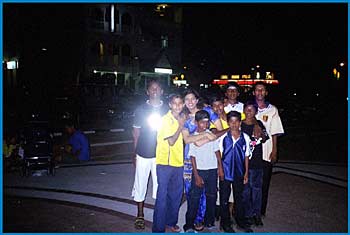
The incredible thing was although I had initially believed I was sent to Malaysia to help these children, I soon found I needed this experience as much as they did. Actually, I think I needed it more. The children changed me in ways I cannot even began to describe.
For example, the biggest problem I had living in the ashram was that I did not speak or understand Tamil and Malay, which were most frequently spoken by the children. Although they were learning English in school, their facility with the language was rudimentary at best.
For the most part, this meant I was unable to provide them with verbal counseling, and would very often be at a loss as to communicate with them. While this limited the role I could play with the children, it opened me up to the importance of non-verbal forms of communication. I had to find a way to befriend these children and earn their trust without words.
It was quite challenging, but during my stay I read something that eventually inspired me to overcome this problem. I read that a person is not remembered for what they say or do, but for how they make you feel. To this end, I found our mutual love and affection to be the universal languages. They allowed us to transcend language barriers.
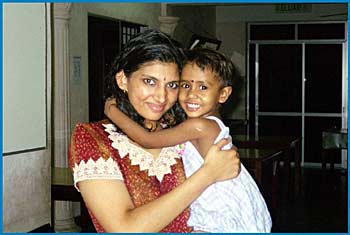
I didn’t realize how deep and strong was the human capacity for love until I met these children. By opening my heart to them, I realized there was more to me than my career, my accomplishments, my education, and my family. The children didn’t really understand nor did they love me for any of these things. They simply loved and trusted without reservation because I loved them.
That’s not to say that they were angels. They could be loud, rowdy, petulant, manipulative, irrational, and down-right impolite at times. In short, they were children. At the end of the day, we would be hard-pressed to find anyone who did not exhibit these behaviours at some point during their lives.
Even when the bad habits from their earlier upbringing arose, I found myself feeling compassion rather than anger. I came to understand that at these times, more than ever, they were crying out for the love and attention they have lived without for so long.
Over the next two months, I spent my time at the ashram playing, tutoring, praying, singing and dancing with the children. We laughed and cried together. Very soon, their English abilities began to improve dramatically, and many of the older children opened up about their lives before the ashram, and about their hopes, dreams and fears for the future.

I realized, as I got to know them, that they were not so different from me. In fact, I could see myself in all of them. As they expressed concerns about their well-being and the future, I recognized that these were the same doubts and fears that I carry in my own heart. I realized that despite background, upbringing, privilege and geography, people are still people. Our similarities outweigh our differences.
We all long for security, contentment and happiness. We spend our lives trying to achieve these things in the best ways we know how, but some of us are blessed with more chances and resources to make this happen than others. Fortunately for these children, the ashram is providing a solid spiritual foundation that will hopefully help them better cope with the challenges they will undoubtedly face throughout their lifetimes.
I cannot express how much I admire these children. Their lives have been marred by difficulty and tragedy, yet they have not given up the capacity to open themselves up to love, and perhaps more importantly, to hope. We could all learn from that. When we look at the world through the innocent eyes of children, it’s amazing how opening ourselves up to hope gives us the courage and optimism to greet each new day as a chance to share in the wonder of God’s creation.
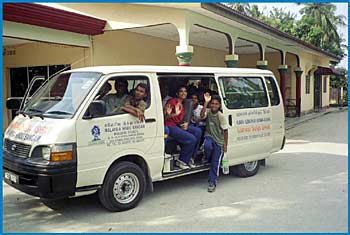
Any discussion about the Sanathana Dharma Ashram is incomplete without giving full credit to the people in Sitiawan who have made this undertaking possible. While the ashram is well supported by Hindus within the community, it is because of the tireless efforts of Uncle Aramban Kumar and his family that the children are blessed with the chance to live at an ashram such as this. He is a formidable man, but seeing how he interacts with the children, it is clear he is raising these children with the same love and care he no doubt gave his own children. He is available to the children any time of the day or night. While the children may perceive him to be a strict disciplinarian, he treats them with nothing but the utmost fairness and dignity. He is the kind of Father that we should all be blessed to have.
He has taught me that in life, we must stand by our convictions, even in the face of opposition and adversity. In truth, there can be no separation between what we call our “professional” and spiritual paths. When we are true to ourselves, and have faith in God, we will get the strength to make everything we do an act of loving service.
In so many ways, my return from Malaysia is the beginning, not the end, of an incredible journey of the mind and spirit. I went to the Ashram to get away from my life. Instead I discovered something inside myself that gave life new meaning. I learned that at the end the day, WHO we are, is far more important than WHAT we are. I have met people who have shown me what it’s like to find goodness and joy in even the bleakest places. This is who I aspire to be. As I work towards this end, I will remember that so long as Love and Hope are our constant companions, we are never alone. These are lessons for which I will always be grateful.
And so, the adventure continues�
Om Namah Sivaya

|
Study Gurudeva’s teachings.
|
transcription begins
Date: June_21_2002
Title: Controlling Anger Part 2
Category: Good Conduct
Duration: 11 min., 37 seconds
Date Given: May 28, 2002
Given by: Bodhinatha
There is a very interesting story relates to anger. It has to do with Gurudeva’s trip to Malaysia in June of 2000. Remember that? When he went to this event related to what is called ‘agnihotra’, homa therapy. It was conducted by Aboorvass in Malaysia. Gurudeva was invited to attend and he checked it out and it seemed like a wonderful idea, thus encouraging people to chant mantras and conduct a little fire ceremony in the home. It is a simple fire ceremony, a home fire ceremony that you can do, called agnihotra. You learn a few simple mantras and do this simple fire ceremony in the home and that is it. Sounds great, right? Harmless, a wonderful idea making people more religious.
Well, that is how Gurudeva was looking at it before he went. After he came back, that wasn’t how he was looking at it. He got very fiery about it. Why? Because he found that many of the people involved in this practice were very angry people. They did not have anger under control. There was anger right under the surface. It was like you could touch them and they would become angry, so to speak. It was just right there and they might have a smile on their face but there was significant anger going on in many of these people. It made Gurudeva ponder, reflect upon this problem of conducting fire worship, if you are an angry person. So he concluded that it was not a good idea.
If someone is in an angry state of mind and they are worshipping through the use of fire, they could be invoking the asuras, bringing negative beings into the home, bringing beings from the inner worlds. When we worship, we bring beings the inner worlds to where we are worshipping. Usually we bring the devas, we bring beings from the up, down so to speak. Higher beings that can help us. But if we are in an angry state of mood, it is almost like black magic. We are not directing it at someone but it is a similar vibration as if it were black magic. So we can bring lower beings up, asuras up into our presence and these asuras can disturb us. These asuras can go home with us, just as the devas go home with us, from a place of worship. The asuras can also go home with us.
So Gurudeva said, “This is not good. I should say something about this.” So he wrote a nice statement in his typical fiery style. “If angry people do puja the invocation calls up the demons, rather than calling down the devas. The asuric beings are invoked into the home by angry people and into the temple by angry priests or by contentious, argumentative sometimes rageful Boards of directors. These asuras take great satisfaction in creating more confusion and escalating simple misunderstandings into arguments leading to angry words, hurt feelings and more. With this in mind, once anger is experienced, 31 days should pass to close the doors on the chakras below the muladhara before puja may again be performed by that individual. Simple waving of incense for the icons is permissible. But not the passing of flame, ringing of bells or the chanting of any mantra other than the simple recitation of Aum.”
So, you can see Gurudeva got, kind of, fired up on that. That’s a very strong statement. 31 days, imagine that! So, not only does it show us something about performing ceremony, such as the fire ceremony or puja which involves flame and a bell. The bell calls the inner plane beings where incense doesn’t call anyone. That is why we always ring the bell when we are burning prayers. We are ringing the bell to make sure someone is there to get the prayer. They are being called by the bell and by the flame, whereas incense doesn’t do that.
Besides that knowledge which is very useful, the 31 days gives us an appreciation of the force we release within ourselves when we become angry. 31 days! It takes 31 days to recover inwardly from this action. That is a long time. So we have really caused an upset in our self. We have really released a tremendous force, negative force, if it takes that long to calm down after doing so.
There is another helpful analysis of anger which is looking at it through the framework of the chakras. The normal chakra system just talks about the seven major chakras starting with the muladhara and going up. But Gurudeva and a few others have also elucidated the seven chakras below the main chakras which are asuric areas.
The second one down is the anger chakra called ‘vitala’ which is described as raging anger, dark red black streaks emblazon the aura when awareness enter this furnace of instinctive fire and then injures others. You can see the color there. It is not just red, it is red with black in it. A bright red is not a negative color. It is the color of physical energy. When you put a lot of black into it, it is a very different vibration. It is energy turning to a negative force. So, red-black.
Gurudeva has a nice statement on that. “The onrush of anger serves to protect man’s private interests in critical situations by injecting adrenaline into his blood and thus preparing him for defense.’ That is how the instinctive mind works, you can see this in animals. “But as man evolves closer to his real actinic being he discovers that actinic love, understanding, compassion and wisdom are higher qualities than anger.”
It is useful too to think of the first chakra below the muladhara which is fear, atala. Because, quite often, people first go into a state of fear and then keep going down in consciousness and end up in a state of anger. So we even want to be careful to avoid fear, fear in ourselves, putting others into fear, like children. We want to keep everyone from being afraid because it is one step down below from where we want to be, it is easy to go the second step.
“The first chakra below the muladhara, fear is passive odic force whereas anger is aggressive odic force.” So fear is an introverted negative state of mind, where anger is extroverted negative state of mind. The chakras work like that. It is like reason when you come up. Reason is an introverted state of mind, whereas will power is extroverted. Then cognition is introverted, Divine love is extroverted.
Another perspective on anger comes from our Sutras. We have five verses in the Nandinatha Sutras by Gurudeva, which refer to anger. The first one is very general. “Worshipers of Siva who are a victim to anger or hatred refrain from meditation, japa and kundalini yoga. They confess sins, do penance, engage in bhakti and karma yoga to raise consciousness.”
One of the reasons for refraining from meditation, japa and kundalini yoga is that they all intensify one’s mental state. So you create an intensity by meditating. If the kundalini goes up, you are more intense. So, if you are prone to anger, that gives your anger more intensity. It makes it worse. You don’t want to take the chance of intensifying your anger, making it worse than it normally would be by intensifying your mental state through those practices.
“Each of Siva’s married men devotees loves and cares for his wife despite any shortcomings. He is forbidden to strike or speak harshly to her or ignore her needs. If he does, he must seek family and professional help.” That one is self evident.
“Siva’s women devotees never become angry with a man, malicious, belittle, verbally abuse him or use other emotional controls such as disdain, accusation, crying or prolonged pouting or silence.” Of course, a woman’s expression of anger tends to be more subtle, more internal than a man’s. A man just blurts it out and says something in angry words or raises his fist or something. A woman keeps it in, but it is still anger and should be avoided.
“Siva’s followers never govern youth through fear. They are forbidden to spank or hit them, use harsh or angry words, neglect or abuse them. They know you cannot make children do better by making them feel worse.”
The last one is, “Even in moderation, Siva’s devotees do not drink alcohol in solitude, when depressed, angry or under extreme stress. When one is emotionally unstable, alcohol inhibits the ability to confront and solve problems.” So, if one is in an angry mood, partaking of alcohol can make it much worse. You give up the control, the small amount of control you may still have.
transcription ends
|
MORE UPLIFTING THINGS |
Innersearch 2003-4 in India!
We just completed the July 17-23 Kauai Innersearch, 2002. Bodhinatha will lead the next Innersearch to India, between Dec 2003 and Jan 2004. We will visit Bangalore and the Iraivan Carving Village, and settle in the South in Tamil Nadu, Click on the above for details on what will be an inspiring journey to our holy land of Bharat! |
|

|
Check our children and youth section for new items for the young and young at heart! | |
|
1. SIGN OUR GUESTBOOK and receive a FREE GIFT |
||
| 2. Newest Book: LIVING WITH SIVA | ||
|
3. Visiting KAUAI’S HINDU MONASTERY |
||
|
4. Contribute to THANK YOU, GURUDEVA FUND |
||
From Our Gurus' Teachings
Archives are now available through 2001. Light colored days have no posts. 1998-2001 coming later.
